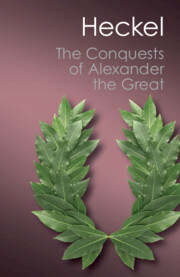Book contents
- Frontmatter
- Contents
- PREFACE
- CHRONOLOGICAL TABLE
- MAP 1 Alexander's Empire
- MAP 2 Greece and Macedonia
- 1 INTRODUCTION
- 2 HOW DO WE KNOW? SOURCES FOR ALEXANDER THE GREAT
- 3 THE MACEDONIAN BACKGROUND
- 4 THE PERSIAN ENEMY
- 5 CONQUEST OF THE ACHAEMENIDS
- 6 RESISTANCE ON TWO FRONTS
- 7 CONQUEST OF THE PUNJAB
- 8 THE OCEAN AND THE WEST
- 9 THE LONG ROAD FROM SUSA TO BABYLON
- APPENDIX 1 ALEXANDER'S OFFICERS
- APPENDIX 2 NUMBERS OF TROOPS
- APPENDIX 3 THE ADMINISTRATION OF THE EMPIRE
- GLOSSARY
- ABBREVIATIONS
- NOTES
- BIBLIOGRAPHY
- INDEX
2 - HOW DO WE KNOW? SOURCES FOR ALEXANDER THE GREAT
Published online by Cambridge University Press: 05 August 2014
- Frontmatter
- Contents
- PREFACE
- CHRONOLOGICAL TABLE
- MAP 1 Alexander's Empire
- MAP 2 Greece and Macedonia
- 1 INTRODUCTION
- 2 HOW DO WE KNOW? SOURCES FOR ALEXANDER THE GREAT
- 3 THE MACEDONIAN BACKGROUND
- 4 THE PERSIAN ENEMY
- 5 CONQUEST OF THE ACHAEMENIDS
- 6 RESISTANCE ON TWO FRONTS
- 7 CONQUEST OF THE PUNJAB
- 8 THE OCEAN AND THE WEST
- 9 THE LONG ROAD FROM SUSA TO BABYLON
- APPENDIX 1 ALEXANDER'S OFFICERS
- APPENDIX 2 NUMBERS OF TROOPS
- APPENDIX 3 THE ADMINISTRATION OF THE EMPIRE
- GLOSSARY
- ABBREVIATIONS
- NOTES
- BIBLIOGRAPHY
- INDEX
Summary
ANCIENT HISTORIANS HAVE LONG HAD TO CONTEND WITH the fact that their knowledge of the past is based on limited, often secondary and unreliable evidence. Statistical analyses fail for want of sufficient data; historical interpretation falters on the broken ground of textual corruption, authorial bias, and the unintentional but misguided superimposition of Roman ideas and institutions on Greek subjects. Documentary evidence is often lacking, or spotty, and almost always in need of at least partial restoration. And such documents as survive are those recorded on nonperishable material, such as stone or metal, or on papyri which have survived as a result of unusual climatic conditions. But, whatever the form of these primary documents, they rarely if ever survived because of the intrinsic value of the information they contained. Rather, inscriptions on marble or limestone were reused as building material, as doorposts, lintels, foundation stones, or steps. Where their inscribed sides have been exposed to the elements or the tread of human feet, their messages have generally been obscured, if not entirely obliterated. In other places, stones have been cut into two or more pieces and their information scattered and partially lost. Histories survived on papyri in many cases because someone found a more important use for the writing material and recorded bills of sale, land registers, or other accounts on the reverse side. Other evidence survives on palimpsests, texts that have been erased so that the medium could be reused; but traces of the ink remain and these texts are sometimes legible under ultraviolet or infrared light.
- Type
- Chapter
- Information
- The Conquests of Alexander the Great , pp. 5 - 12Publisher: Cambridge University PressPrint publication year: 2012



